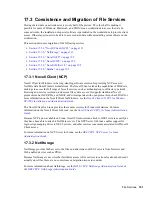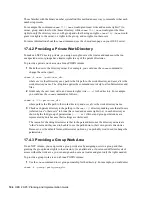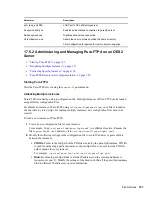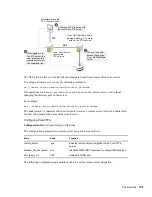
File Services
193
Use the information in this section to understand how you can configure POSIX directories to more
closely align with the NCP model.
Section 17.4.1, “Managing Access Rights,” on page 193
Section 17.4.2, “Providing a Private Work Directory,” on page 194
Section 17.4.3, “Providing a Group Work Area,” on page 194
Section 17.4.4, “Providing a Public Work Area,” on page 195
Section 17.4.5, “Setting Up Rights Inheritance,” on page 196
17.4.1 Managing Access Rights
NCP directories are, by default, private. When you assign a user or a group as a trustee of a directory
or file, those trustees can automatically navigate to the assigned area and exercise whatever access
privileges you have assigned at that level and below. You can assign as many trustees with different
access privileges as you need.
On the other hand, Linux POSIX directories can be accessed through three sets of permissions
defined for each file object on a Linux system. These sets include the read (r), write (w), and execute
(x) permissions for each of three types of users: the file owner, the group, and other users. The Linux
kernel in OES 2 also supports access control lists (ACLs) to expand this capability. However, ACLs
are outside the scope of this discussion. For more information on ACLs, see
“Access Control Lists”
(http://www.novell.com/documentation/sles10/sles_admin/data/cha_acls.html)
in the
SLES 10 SP3:
Installation and Administration Guid
e (http://www.novell.com/documentation/sles10/sles_admin/
data/sles_admin.html)
.
The Linux
chown
command lets you change the file owner and/or group to a LUM user or a LUM-
enabled group. For example,
chown -R user1 /home/user1
changes the owner of the
user1
home directory and all its subdirectories and files to user1. For more information, see the chown
man page on your OES 2 server.
The Linux
chmod
command provides a very simple and fast way of adjusting directory and file
access privileges for the three user types: owner, group, and other (all users). In its simplest form,
the command uses three numbers, ranging from 0 through 7, to represent the rights for each of the
three user types. The first number sets the rights for the owner, the second number sets the rights for
the group, and the third number sets the rights for all others. Each number represents a single
grouping of rights, as follows:
Number
Setting
Binary Representation
0
- - -
0 0 0
1
- - x
0 0 1
2
- w -
0 1 0
3
- w x
0 1 1
4
r - -
1 0 0
5
r - x
1 0 1
6
r w -
1 1 0
7
r w x
1 1 1
Содержание OPEN ENTERPRISE SERVER - CONVERSION GUIDE 12-2010
Страница 12: ...12 OES 2 SP3 Planning and Implementation Guide...
Страница 24: ...24 OES 2 SP3 Planning and Implementation Guide...
Страница 50: ...50 OES 2 SP3 Planning and Implementation Guide...
Страница 74: ...74 OES 2 SP3 Planning and Implementation Guide...
Страница 78: ...78 OES 2 SP3 Planning and Implementation Guide...
Страница 80: ...80 OES 2 SP3 Planning and Implementation Guide...
Страница 96: ...96 OES 2 SP3 Planning and Implementation Guide...
Страница 146: ...146 OES 2 SP3 Planning and Implementation Guide...
Страница 176: ...176 OES 2 SP3 Planning and Implementation Guide...
Страница 210: ...210 OES 2 SP3 Planning and Implementation Guide...
Страница 218: ...218 OES 2 SP3 Planning and Implementation Guide...
Страница 226: ...226 OES 2 SP3 Planning and Implementation Guide...
Страница 234: ...234 OES 2 SP3 Planning and Implementation Guide...
Страница 236: ...236 OES 2 SP3 Planning and Implementation Guide...
Страница 244: ...244 OES 2 SP3 Planning and Implementation Guide...
Страница 246: ...246 OES 2 SP3 Planning and Implementation Guide...
Страница 250: ...250 OES 2 SP3 Planning and Implementation Guide...
Страница 254: ...254 OES 2 SP3 Planning and Implementation Guide...
Страница 258: ...258 OES 2 SP3 Planning and Implementation Guide...
Страница 284: ...284 OES 2 SP3 Planning and Implementation Guide...
Страница 286: ...286 OES 2 SP3 Planning and Implementation Guide...
Страница 294: ...294 OES 2 SP3 Planning and Implementation Guide...
















































